- Home
- About Journals
-
Information for Authors/ReviewersEditorial Policies
Publication Fee
Publication Cycle - Process Flowchart
Online Manuscript Submission and Tracking System
Publishing Ethics and Rectitude
Authorship
Author Benefits
Reviewer Guidelines
Guest Editor Guidelines
Peer Review Workflow
Quick Track Option
Copyediting Services
Bentham Open Membership
Bentham Open Advisory Board
Archiving Policies
Fabricating and Stating False Information
Post Publication Discussions and Corrections
Editorial Management
Advertise With Us
Funding Agencies
Rate List
Kudos
General FAQs
Special Fee Waivers and Discounts
- Contact
- Help
- About Us
- Search

The Open Virtual Reality Journal
(Discontinued)
ISSN: 1875-323X ― Volume 3, 2014
Cybersickness Influences the Affective Appraisal of a Virtual Environment
Alexander Toet*, 1 , Erik D van der Spek2, Joske M. Houtkamp2
Abstract
We investigated if cybersickness has an effect on the affective appraisal of a virtual environment (VE). For many applications it is essential that users experience the simulated environment in a similar way as the corresponding real one. Navigation through VEs is known to negatively influence the physical well-being of observers by inducing cybersickness. Since people tend to misattribute their feelings to the environment they perceive, cybersicknesss may influence their affective appraisal of a VE. Participants passively watched a simulated walk through a VE, while the visual scene continuously performed a quasi-sinusoidal frontal roll oscillation. Immediately after the exposure, they reported their experienced level of cybersickness and assessed the environment on a semantic differential scale. People experiencing cybersickness rated the environment as less pleasant and more arousing, as compared to people with no symptoms. Thus, users suffering from cybersickness misattributed their unpleasant feelings to the affective qualities of the VE. Applications that rely on VEs to evoke the same emotional and affective user responses as their real equivalent should therefore minimise or account for the incidence of cybersickness.
Article Information
Identifiers and Pagination:
Year: 2010Volume: 2
First Page: 26
Last Page: 31
Publisher Id: TOVRJ-2-26
DOI: 10.2174/1875323X01002010026
Article History:
Received Date: 30/8/2010Revision Received Date: 30/9/2010
Acceptance Date: 10/10/2010
Electronic publication date: 15 /11/2010
Collection year: 2010
open-access license: This is an open access article licensed under the terms of the Creative Commons Attribution Non-Commercial License (http://creativecommons.org/licenses/by-nc/3.0/) which permits unrestricted, non-commercial use, distribution and reproduction in any medium, provided the work is properly cited.
* Address correspondence to this author at TNO Human Factors, P.O. Box 23, 3769 ZG Soesterberg, The Netherlands; Tel: (+31) 346 356 237; Fax: (+31) 346 353 977; E-mail: lex.toet@tno.nl
| Open Peer Review Details | |||
|---|---|---|---|
| Manuscript submitted on 30-8-2010 |
Original Manuscript | Cybersickness Influences the Affective Appraisal of a Virtual Environment | |
INTRODUCTION
3D computer models of the built and rural environment are widely used in interactive desktop applications for architectural visualizations, urban and landscape planning, and serious gaming and training. For these applications it is essential that the virtual environment provides an ecologically valid experience: users should experience the VE it in the same way as a corresponding real environment. Only then can we expect the user to react in a similar way to the simulated environment as to a corresponding real one. It is often implicitly assumed that a “realistic” or “verisimilar” simulated environment automatically induces a valid user experience [1]. However, the perception of the affective qualities of an environment (how pleasant, unpleasant, exciting, boring, upsetting, or soothing it is) may be biased by a person’s affective state [2]: people tend to misattribute their feelings to the perceived environment [3].
Despite significant progress in simulation technology, self-motion simulation in VR still poses a major challenge [4]. Playing computer games or passively watching simulated self-motion through VEs without experiencing actual motion may induce cybersickness [5-7]) The main symptoms of cybersickness include nausea, oculomotor disturbances such as eye strain, disorientation, vertigo, postural instability, and vomiting ([8, 9]). These effects may linger once the interaction with the VE has concluded [9, 10]. For many years driving, flying and sailing simulators have been known to cause cybersickness, afflicting up to more than 70-80% of the users [11, 12], which negatively affects the effectiveness of these trainings. Recently, cybersickness with desktop and console systems has become an important issue, due to the increasing use of these systems for visualization and serious gaming applications [12-14]. However, it is currently not known whether the affective appraisal of a VE is influenced by visually induced motion sickness (cybersickness). This study investigates whether people suffering from cybersickness misattribute their unpleasant feelings to the affective qualities of the perceived VE.
MATERIALS AND METHODOLOGY
Equipment
The experiment was conducted using two different computers. One was a Dell XPS700 desktop pc with an Intel Core2 Duo 6600 chipset, running at 2.4 GHz and with 2GB of RAM. The video card was a GeForce 7950 GX2 in dual SLi mode, with 1024MB of RAM. The other computer was a Dell XPS600, with an Intel Pentium 4 processor, running at 3.6 GHz and containing 1GB of internal RAM. This computer’s video card was a GeForce 7800GTX in dual SLi mode, with 256MB RAM. Both computers used a Toshiba TDP-P6 beamer to back-project the generated virtual environment on a semi-transparent (‘frosted’) screen 1.46 by 1.09 meters in dimensions, at a resolution of 1024 by 768 pixels, with a screen refresh rate of 75 Hz.
Participants
A total of 32 persons (15 males and 17 females) participated in the experiment in return for monetary compensation. Two persons had to forfeit prematurely because they surpassed the preset level of cybersickness that was adopted as an upper limit in this experiment. The age of the remaining 30 participants ranged from 20 to 65 years, with an average of 45.8 years, and a standard deviation of 15.2 years. All participants were healthy and had no significant susceptibility to motion sickness and related phenomena, as determined through self-report by means of a health questionnaire. Only 6 participants had some experience with first person shooter games. Two of those had some experience with HALF-LIFE 2, but none of them recognized any of the scenes shown in the course of the experiment. The experimental protocol was approved by TNO Human Factors internal review board on experiments with human participants. The participants gave their written informed consent prior to testing.
Viewing Conditions
The experiment was performed in a dimly lit room, using two similar set-ups separated by black curtains. Participants were seated in a comfortable chair with their head against a raised headrest, at approximately 1.2 meters viewing distance from the projection screen, resulting in a geometrical field of view of 60 degrees. Their visual straight ahead was aligned with the centre of the screen. About 10% of the participants suffered from nausea at different stages during the experiment. When participants verbally informed the experimenter of their misery, they were allowed to sit slightly further away from the screen, as this probably would not significantly influence the mental representation of the virtual world [15].
Stimuli
Subjects viewed a simulated walk through a virtual environment. The virtual environment was generated with the graphics engine of the game HALF-LIFE 2 (the ‘Source’ engine) and comprises rural, mostly coastline, areas, an industrial vista and an urban area, depicting a city with mixed European architecture (Fig. 1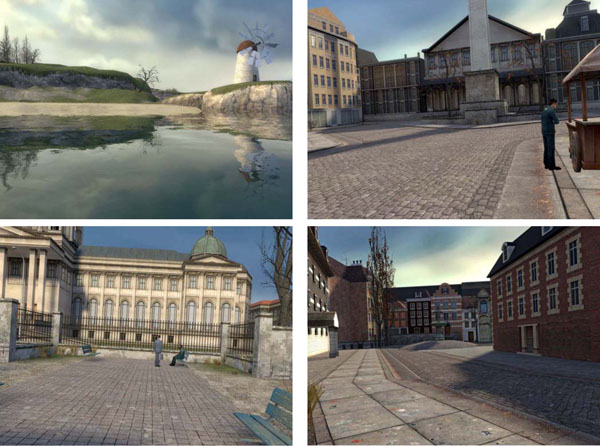 ). Due to the use of a contemporary game engine, the graphics are up to modern day standards.
). Due to the use of a contemporary game engine, the graphics are up to modern day standards.
 |
Fig. (1) Screen shots from the virtual environment used in this study. (a) Coastline view. (b-d) Urban areas. (d) Target area. |
The navigation through the virtual space was passive, i.e. without user control, in order to assure that every person had the same impression of the environment. The simulated walkthrough started at a beach and ended in a city, and lasted about 12 minutes. At the end of the first walkthrough, the presentation started over and ran for another 5 minutes, resulting in a total presentation duration of 17 minutes. The presentation stopped at a designated location in the city. The participant was then asked to appraise the environment displayed at that moment. The walk through the rural part of the environment, starting at the beach, served to focus the attention of the participants on the urban area once they arrived there, and prevented a monotonous experience. By duplicating the first part of the walkthrough the presentation duration could be extended, without the need to extend the simulated environment.
The virtual walk took place at a simulated speed of 13.6 km/h. Our aim was to induce cybersickness without hindering the formation of an affective appraisal. To increase the imagery’s potential to provoke sickness, we used a large geometrical field-of-view (60º) in combination with an erratic swaying camera motion about an axis at foot level and with a peak amplitude of 8º. This camera motion lasted for the entire duration of the simulation. These parameter settings were likely to induce cybersickness within a relatively small amount of time [16], before participants would get bored (a mood which might confound the affective appraisal).
Previous research indicated that motion sickness related symptoms are most prevalent when either a roll or pitch motion is performed [17, 18]. In this experiment we used a roll motion since this ensures less distortion of the scenery to be appraised (see (Fig. 2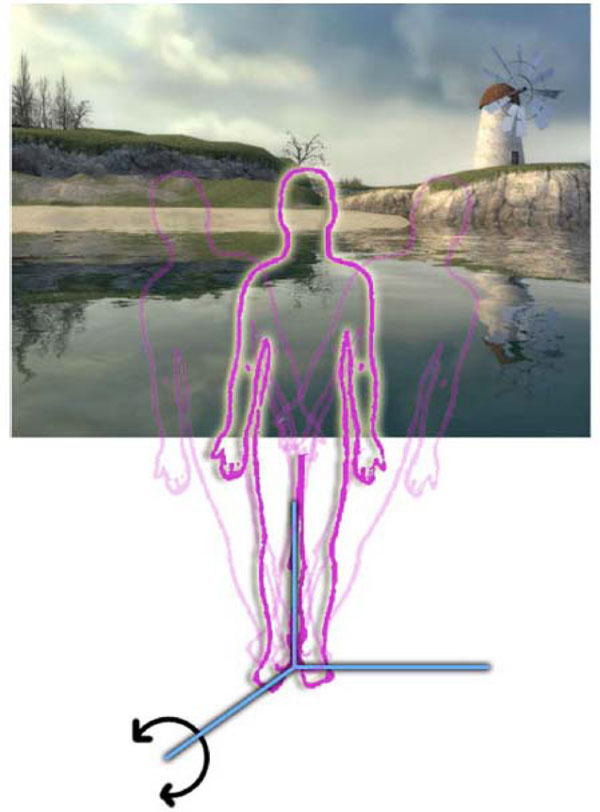 ) for a pictorial representation of the roll axis). However, during a pilot experiment it became apparent that participants were able to accustom to the roll motion when a regular sinusoid was implemented. Therefore an unpredictable complex harmonic swaying motion was used, implemented as a linear combination of three sinusoids. The time (t, in s) dependent amplitude A (deg) of this motion ranged between -8 and 8 degrees, and was defined as
) for a pictorial representation of the roll axis). However, during a pilot experiment it became apparent that participants were able to accustom to the roll motion when a regular sinusoid was implemented. Therefore an unpredictable complex harmonic swaying motion was used, implemented as a linear combination of three sinusoids. The time (t, in s) dependent amplitude A (deg) of this motion ranged between -8 and 8 degrees, and was defined as
 |
Fig. (2) Pictorial representation of the roll axis. |
where φ represents the (dimensionless) phase, max the maximum operator, and a = 7.2 , b = 4.1 and c = 4 are constants. These constants were selected in order to achieve the highly erratic oscillation shown in Fig. (3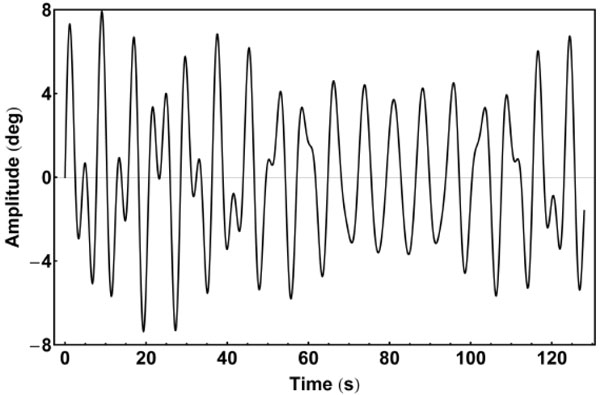 ).
).
 |
Fig. (3) Schematical representation of the roll oscillation. |
Measurement Scales
Most studies on motion, simulator and cybersickness use the Simulator Sickness Questionnaire (SSQ) [19], a subjective self-report scale first introduced by Kennedy and Lane [20]. However, the SSQ, while giving an accurate depiction of cybersickness, is a rather long questionnaire. As the average affective appraisal questionnaire used in this study is also comprehensive, we feared that cybersickness could subside over the course of the final appraisal task. Furthermore, this is an exploratory research study and the effect of cybersickness was deemed more important than the cybersickness itself. We therefore decided to use a short 0-10 index score scale, the Misery Scale (MISC), for the evaluation of cybersickness [21]. The MISC scores range from no symptoms (0), undeterminable symptoms (1) and slight determinable symptoms (2) gradually upwards to vomiting (10). We adopted a MISC score of 8 as a break-off criterion, i.e. subjects who reported a MISC score of 8 or higher were allowed to stop.
The affective appraisal of the virtual environment was rated using the eight point semantic differential scale developed by Russell and Pratt [22]. This scale describes the affective qualities of a molar environment as a 2D space, with the independent dimensions unpleasant-pleasant and arousing-sleepy on the two main axes. Diagonally through these axes are the dimensions exciting-gloomy and distressing-relaxing, which can optionally be inferred from the two main axes. Participants rate a list of 40 affective adjectives, which are then grouped into the two dimensions comprising the appraisal.
Procedure
First, participants read and signed an informed consent.
Second, they filled in a questionnaire that assessed (a) their physical and mental state, (b) their past susceptibility to motion sickness and related phenomena, and (c) their proficiency with virtual environments and computer games, first person shooters and HALF-LIFE 2 in particular. This latter information is important, since participants who have previously played HALF-LIFE 2 may recall set pieces from the original game that were used in the construction of the virtual environment for the present study, and may associate these pieces with environments they previously encountered in the HALF-LIFE 2 game. Such associations could in turn influence their appraisal of the environments shown in the present study. Only two participants reported having played HALF-LIFE 2, but when prompted afterwards both stated they had not recognized any locale in the course of the experiment.
Third, participants rated the affective qualities of a picture of typical Dutch Neo-Classical / Neo- Renaissance style canal houses and a picture of 7th avenue in New York, on Russell and Pratt’s environment description scale [22]. This was done primarily to accustom the participants with the measurement scale, but also to ascertain whether the appraisal of a Dutch cityscape was homogeneous among the participants, as the final environment to be appraised resembled these buildings.
After completing the aforementioned three questionnaires, the participants were delegated to the darkened experiment room and seated in the setup. There they watched the 17-minute tour of the virtual environment. During this presentation they were prompted to note down their MISC scores every five minutes, and at the end. At the end of the tour the camera froze on the area depicted in Fig. (1d ). Then, the lights in the room were turned on dimly, and the participants appraised this particular part of the environment with Russell and Pratt’s affective scale.
). Then, the lights in the room were turned on dimly, and the participants appraised this particular part of the environment with Russell and Pratt’s affective scale.
Hypothesis
Prior to the experiment nearly all participants found an exemplary Neo-Renaissance style architectural cityscape to be pleasant and, for the greater part, slightly sleepy (Fig. 4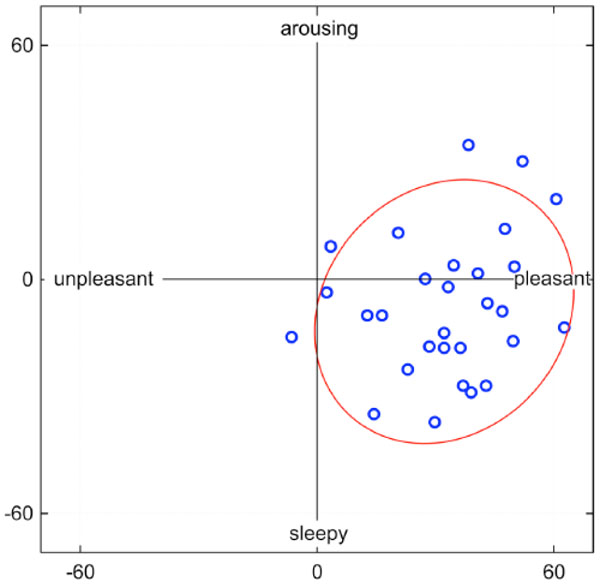 ). Given the facts that cybersickness causes physical discomfort, and that people tend to misattribute their feelings to the environment they perceive, we hypothesized that cybersick participants would find this type of cityscape less pleasant.
). Given the facts that cybersickness causes physical discomfort, and that people tend to misattribute their feelings to the environment they perceive, we hypothesized that cybersick participants would find this type of cityscape less pleasant.
 |
Fig. (4) Scatterplot with 95% confidence ellipse detailing the affective appraisals of a picture of Neo-Renaissance buildings that resembled the target area of (Fig. 1d). |
RESULTS
30 Participants finished the experiment. Of these, 7 reported no effect at all during the whole exposure, and 13 reported feeling fine at the end of the virtual tour. The last MISC report was used as the criterion for the following statistical analysis, as it most accurately described the participant’s wellbeing during the appraisal task. The small number of participants per MISC score meant that an accurate decomposition of the effect of different degrees of cybersickness on the affective appraisal of virtual environments was problematic. This was further complicated by the fact that participants could stop after reporting an 8, while the onset of nausea, which would hypothetically lead to the highest change in affective appraisal, doesn’t start until level 6. Although a simple multivariate regression did return a significant result, the small amount of participants that finished the experiment with cybersickness, the apparent high variation per MISC score, and the non-normality in the participants’ age distribution, gives the model a low fidelity. Therefore the participants experiencing cybersickness were pooled into a single group, which makes for a more robust comparison. The MISC score can be divided into three categories: participants experiencing no effect (0), participants experiencing undeterminable symptoms (1), and participants experiencing determinable symptoms in varying amounts of severity (2-10).
As determinable cybersickness is onset from a score of 2 or higher, this semantic divide was chosen as the demarcation criterion. Consequently two groups were formed, one consisting of 19 participants who were deemed physically well, and one consisting of 11 participants, who were deemed cybersick.
The environment description scale of Russell and Pratt [22] describes the environment on four dimensions: pleasant-unpleasant, arousing-sleepy, distressing-relaxing and exciting-gloomy. The scores on these dimensions are computed by rating individual adjectives, for instance ‘tranquil’ or ‘repulsive’, on their applicability to the environment. Fig. (5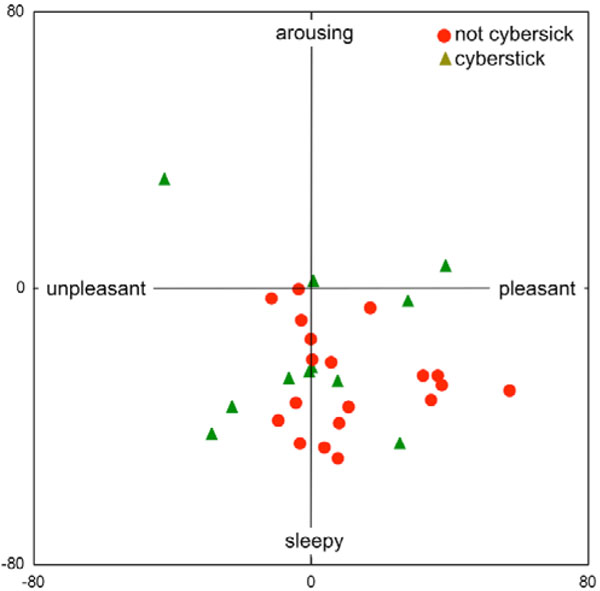 ) shows the affective appraisals of the target area of (Fig. 1d
) shows the affective appraisals of the target area of (Fig. 1d ) for each of the two groups of participants (cybersick and not-cybersick).
) for each of the two groups of participants (cybersick and not-cybersick).
 |
Fig. (5) Scatterplot detailing the affective appraisals of the target area of (Fig. 1d). |
A MANOVA [23] was performed to assess the overall effect of cybersickness on the appraisal of the area, which consists of 4 dimensions (pleasant-unpleasant, arousing-sleepy, distressing-relaxing and exciting-gloomy). A post-hoc Tukey test [23] was performed to further assess the effect of cybersickness on each of the individual dimensions. The results are shown in Fig. (6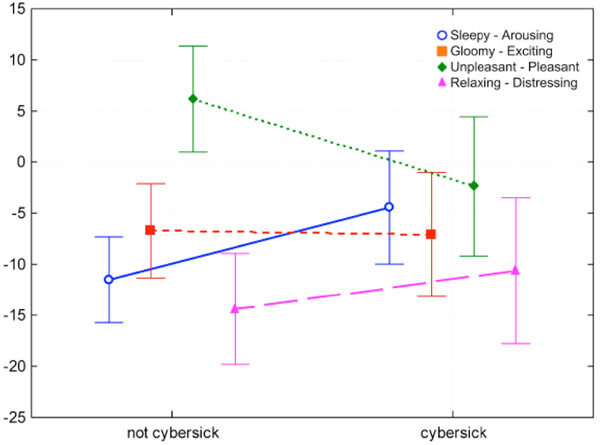 ), where the affective dimensions differ significantly as a result of the cybersickness: N = 30, Wilks λ = 0.52, F(4,25) = 5.723, p < 0.003. In this plot, a high score on the arousing-sleepy scale corresponds to a high level of arousal, while a low score indicates a low arousal (or highly sleepy). Likewise, a high score on the pleasant-unpleasant dimension corresponds to a high level of attributed pleasantness; a high score on the exciting-gloomy dimension indicates the participant found the environment exciting; and scoring high on the distressing-relaxing scale means the environment is distressing. Fig. (6
), where the affective dimensions differ significantly as a result of the cybersickness: N = 30, Wilks λ = 0.52, F(4,25) = 5.723, p < 0.003. In this plot, a high score on the arousing-sleepy scale corresponds to a high level of arousal, while a low score indicates a low arousal (or highly sleepy). Likewise, a high score on the pleasant-unpleasant dimension corresponds to a high level of attributed pleasantness; a high score on the exciting-gloomy dimension indicates the participant found the environment exciting; and scoring high on the distressing-relaxing scale means the environment is distressing. Fig. (6 ) shows even more change than was initially hypothesized. Participants who are cybersick ostensibly not only find the environment less pleasant, but also more arousing.
) shows even more change than was initially hypothesized. Participants who are cybersick ostensibly not only find the environment less pleasant, but also more arousing.
 |
Fig. (6) The effect of cybersickness on the affective appraisal. |
Examining these scores with a post-hoc Tukey test reveals that the significant result of the four dimensions combined is mostly due to a significant effect on the pleasant-unpleasant dimension (p < 0.05), while the effect on the arousing/sleepy scale barely reaches significance (p < 0.052). Differences in the exciting/gloomy and distressing-relaxing scale are insignificant however, so the regression line representing distressing-relaxing should be regarded with caution. If the possible outlier in the second quadrant is deleted, excluding this person from the scores still makes the overall affective appraisal significantly different for the cybersickness predictor (N = 29, Wilks’ λ = 0.55, F(4,24) = 4.995, p < 0.005), but the singular significance in the post-hoc Tukey tests disappears for both arousal-sleepy and pleasant-unpleasant.
Fig. (6 ). The effect of cybersickness on the affective appraisal.
). The effect of cybersickness on the affective appraisal.
DISCUSSION
Our results show that participants experiencing cybersickness assess a simulated environment as less pleasant and more arousing than participants who do not experience any appreciable symptoms of cybersickness. This should by no means be considered trivial; while the thought that a less enjoyable experience leads to a less enjoyable rating of the medium may be relatively straightforward, the subtlety here lies in the fact that the participants were asked to rate the affective qualities (i.e. the affect inducing capabilities) of the virtual cityscape. In this study cybersickness was induced by camera movement, and not by the cognitive or affective qualities of the buildings represented in the environment. All the participants additionally had a preference for the building style to be appraised, as witnessed by the pre-test. Furthermore, all viewers watched the same simulated walk through the environment, eliminating the possibility of different experiences other than those brought about by cybersickness. Therefore, whenever a participant was asked to objectively appraise the affective qualities of the environment, his or her own change in affective state influenced the appraisal.
Why cybersickness actually changes the affective appraisal of the virtual environment is not yet evident. Maybe participants misattributed the change in core affect they experienced while watching the virtual tour to the environment itself [2]. Regardless, cybersickness incidence should be considered a covariate to using virtual environments for affective purposes. This result furthermore implies that cybersickness may compromise the effectiveness of simulations used for training, education and serious gaming applications, as different affective appraisals of a certain environment will likely lead to different decision outcomes. Finding and eliminating the causes of cybersickness is an important factor in trying to construct the right ambiance of a virtual environment. We conclude that applications that rely on VEs to evoke the same emotional and affective user responses as their real equivalent, should minimise or at least account for the incidence of cybersickness.
ABRREVIATIONS
| MISC | = Misery Scale |
| SSQ | = Simulator Sickness Questionnaire |
| VE | = Virtual Environment |
| VR | = Virtual Reality |
ACKNOWLEDGEMENT
This research has been supported by the GATE project, funded by the Netherlands Organization for Scientific Research (NWO) and the Netherlands ICT Research and Innovation Authority (ICT Regie).
